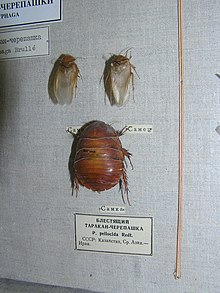| Corydiidae Temporal range: | |
|---|---|
 | |
| Polyphaga pellucida in the Saint Petersburg Zoological Museum | |
| Scientific classification | |
| Domain: | Eukaryota |
| Kingdom: | Animalia |
| Phylum: | Arthropoda |
| Class: | Insecta |
| Order: | Blattodea |
| Superfamily: | Corydioidea |
| Family: | Corydiidae Saussure & Zehntner, 1893 |
| Subfamilies | |
Corydiinae Contents | |
| Synonyms | |
Polyphagidae | |
Corydiidae, previously known as Polyphagidae, [2] is a family of the order Blattodea (cockroaches). Many are known as sand cockroaches. The family is divided into five subfamilies, comprising some 40 genera. [3] [4] One prominent species is the desert cockroach, Arenivaga investigata .